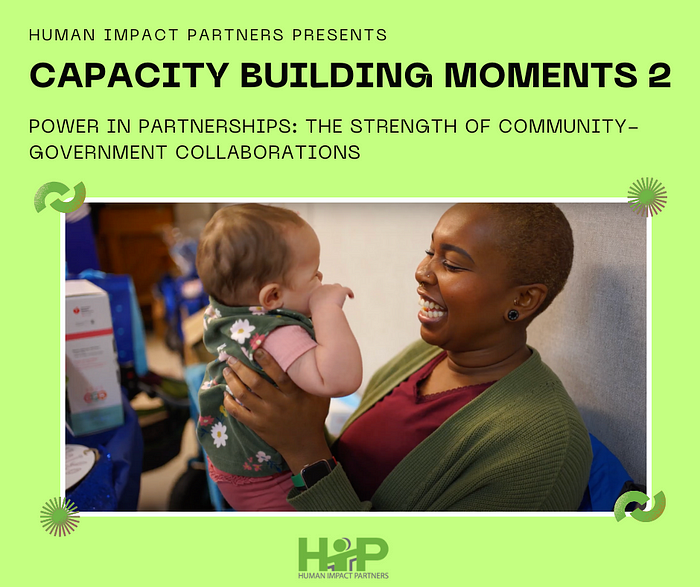Capacity Building Moments #2
Power in Partnerships: The Strength of Community-Government Collaborations

“Power properly understood is nothing but the ability to achieve purpose. It is the strength required to bring about social, political, and economic change… Power at its best is love implementing the demands of justice, and justice at its best is power correcting everything that stands against love.”
— Reverend Dr. Martin Luther King Jr.
At HIP, we believe that unjust power imbalances and structural oppression — including racism, patriarchy, heterosexism, and capitalism — are the most upstream root causes of health inequity. Long histories of structural oppression have concentrated power and resources in the hands of a few, creating vast inequities in access to healthcare, education, housing and employment opportunities across race, gender, and other identities.
That’s why power-building is at the heart of structural change toward health equity. We’ve seen time and time again that healthy communities happen when people are empowered to make their own decisions about their health and have access to the resources to take care of each other. We envision a future where all people have not just a seat at the table, but true autonomy and ownership in decision making around their own lives.
Our capacity building and bridging work facilitates cross-sector partnerships to build the power of communities and improve our collective wellbeing — because to us, collaboration and relationships are central to all change, including power-building.
In this CB Moments blog, we’re sharing how deep and trusting partnerships between governmental public health agencies and community-based organizations can create powerful community-led policies, practices, and changes that would otherwise be unattainable.
Public health agencies bring their positional power, monetary and non-monetary resources, and data-driven insights to the table, while community based organizations, which have long advocated alongside communities and filled gaps in care left by governmental public health agencies, have the relationships and analysis to mobilize residents and advocate for their specific needs and concerns.
Our recent Powerful Partnerships for Healthy Communities Video Series shares three examples from across the country of power-building partnerships between governmental public health agencies and community organizations. Each video highlights the transformative potential of community-led initiatives, mutual respect, authentic relationships, and government accountability, to build the power of communities to achieve their collective purpose.
The series makes clear that successful relationships for health equity require dedication to achieving shared understanding, respect, vision, strategic alignment, and the time it takes to build trust — particularly because of the histories of harm caused by governmental public health agencies in communities.
A look at how three very different partnerships have navigated complex challenges to build community power:
1. Transformative Climate Communities for All
A Partnership between Strategic Growth Council and Leadership Counsel for Justice and Accountability to Expand Access to State Climate Funding for Unincorporated Communities
The Leadership Counsel for Justice and Accountability (LCJA), a community power-building organization, partnered with the California Strategic Growth Council (SGC) to expand the Transformative Climate Communities (TCC) Program eligibility to Disadvantaged Unincorporated Communities (DUCs). The TCC Program invests in development and infrastructure projects that achieve environmental, health, and economic benefits in California’s most disadvantaged communities. However, in its first iteration, DUCs were ineligible to apply for funding. This partnership changed that by expanding eligibility to DUCs, bringing more funding opportunities to communities that have traditionally experienced disinvestment.
2. The Home Team
A Partnership between Washington Department of Public Health Women, Infants, and Children (WIC) and Byrd Barr Place to Engage Black Birthing Families in Program Design
The Home Team tells the story of a partnership between Washington Department of Public Health Women, Infants, and Children (WIC) Nutrition Program and Byrd Barr Place, a community-based organization, and how they began reimagining what care for Black birthing people looks like under the WIC program. The partnership piloted a community advisory group, called The Home Team, to create a space for Black birthing community members to share feedback on their experiences in WIC and discuss opportunities to improve the program.
3. K’yawaka’a hon’ A:ho’i/Water is Life
A Water Conservation Partnership between Zuni Youth Enrichment Project, Zuni Public School District, and Zuni Utility Department
This film documents the residential rebate program implemented by the Zuni Youth Enrichment Project (ZYEP) in partnership with the Zuni Utility Department. In the midst of a 20-year drought, the initiative focused on harvesting rainwater for household use and supported water conservation and food sovereignty efforts on the pueblo. This effort happened in parallel with an initiative by the Zuni Public School District to expand its existing rain harvest program for school-based agriculture production with hopes of becoming a water hub.
Do you work at a governmental public health agency? Are you wondering how to start or deepen collaboration with community power-building organizations?
Check out the following HIP resources to get started:
- Powerful Partnerships Webinar Recording, 10/31/2023 featuring panelists from the three partnerships highlighted here
- Resources for Collaboration and Power Sharing Between Government Agencies and Community Power-Building Organizations
- Activities to Deepen Your Power-Building Analysis
Stay up to date on CB Moments and HIP Capacity Building:
- Visit our website & YouTube channel
- Sign up for HIP’s newsletter
- Connect with HIP Capacity Building staff at APHA November 12–15, 2023.
Coming Soon: CB Moment #3 — Building Containers for Equity Work
To learn more about HIP’s capacity building services, please contact Kia Thacker, Director of Capacity Building at kia@humanimpact.org.
